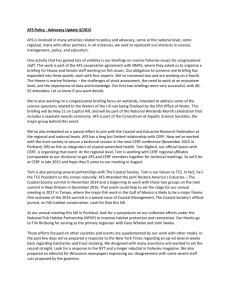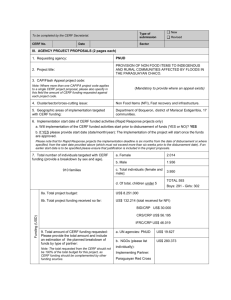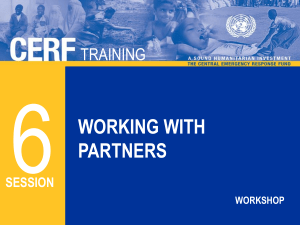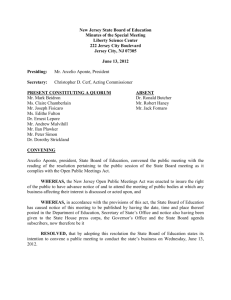CERF Annual RC/HC Report
advertisement
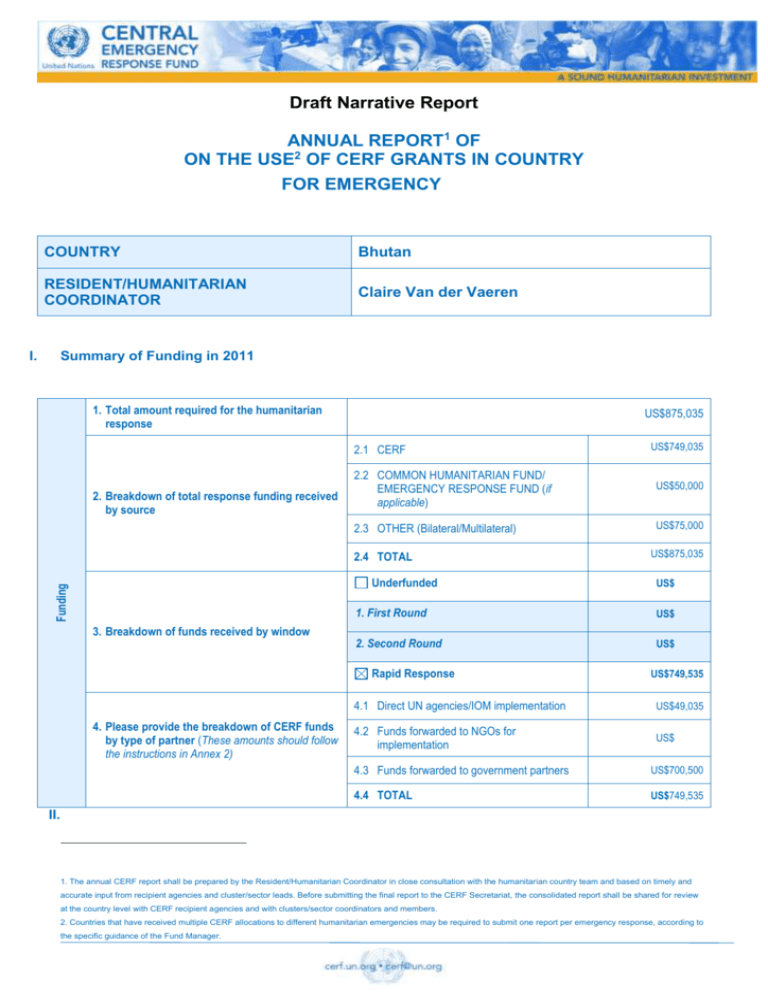
Draft Narrative Report ANNUAL REPORT1 OF ON THE USE2 OF CERF GRANTS IN COUNTRY FOR EMERGENCY Bhutan RESIDENT/HUMANITARIAN COORDINATOR Claire Van der Vaeren Summary of Funding in 2011 1. Total amount required for the humanitarian response US$875,035 2.1 CERF 2. Breakdown of total response funding received by source US$50,000 2.3 OTHER (Bilateral/Multilateral) US$75,000 Underfunded 3. Breakdown of funds received by window US$875,035 US$ 1. First Round US$ 2. Second Round US$ Rapid Response 4. Please provide the breakdown of CERF funds by type of partner (These amounts should follow the instructions in Annex 2) US$749,035 2.2 COMMON HUMANITARIAN FUND/ EMERGENCY RESPONSE FUND (if applicable) 2.4 TOTAL Funding I. COUNTRY US$749,535 4.1 Direct UN agencies/IOM implementation US$49,035 4.2 Funds forwarded to NGOs for implementation US$ 4.3 Funds forwarded to government partners US$700,500 4.4 TOTAL US$749,535 II. 1. The annual CERF report shall be prepared by the Resident/Humanitarian Coordinator in close consultation with the humanitarian country team and based on timely and accurate input from recipient agencies and cluster/sector leads. Before submitting the final report to the CERF Secretariat, the consolidated report shall be shared for review at the country level with CERF recipient agencies and with clusters/sector coordinators and members. 2. Countries that have received multiple CERF allocations to different humanitarian emergencies may be required to submit one report per emergency response, according to the specific guidance of the Fund Manager. II. Summary of Beneficiaries per Emergency Total number of individuals affected by the crisis Individuals 34,695 Female 3,816 Male 4,500 Total individuals (Female and male) 8,316 Of total, children under 5 1,259 Total number of individuals reached with CERF funding III. Geographical Areas of Implementation The earthquake impacted all of Bhutan’s twenty districts: Thimphu, Paro, Haa, Samtse, Bumthang, Wangduephodrang, Dagana, Sarpang, Mongar, Trashigang, Trashi Yangtse, Pema Gatshel, Lhuentse, Samdrup Jongkhar, Gasa, Punakha, Chukha, Sarpang, Tsirang and Zhemgang. The UNDP part of the CERF grant was used for shelter support in the twelve most affected districts (Paro, Haa, Chukha, Samtse, Dagana, Gasa, Sarpang, Zhemgang, Trongsa, Punakha, Mongar). Of the total 34,695 people affected, 30,905 are from these twelve districts, and out of the 6,939 affected households, 6,226 households were in these districts (4,862 in damage category 1 (minor damages), 996 in category II (major damages) and 369 in category III(beyond repair/total collapse)). IV. Process and Consultation Summary I) Was the CERF report discussed in the Humanitarian and/or UN Country Team and by cluster/sector coordinators? YES NO Remarks: The CERF report was dicussed in a meeting on 5 March 2012 between the Shelter and NFRI task team (UNDP) and the Education task team (UNICEF) coordinators with participation of relevant staff from UNDP, UNICEF and the UNRCO. II) Was the final CERF report shared for review with in-country stakeholders (i.e. the CERF recipient agencies, cluster/sector coordinators and members and relevant government counterparts)? YES NO Please elaborate with whom you have shared the reports. - Department of Disaster Management, Ministry of Home and Cultural Affairs - Shelter and NFRI task team - Education task team - UNICEF Representative - UNDP Representative/UN Resident Coordinator - Co-chair, UN Environment and Disaster Management Theme Group - Country Programme Manager, UNDP Regional Bureau for Asia and Pacific 2 V. ANALYSIS 1. The humanitarian context GUIDANCE - 1. Briefly provide an overview of the humanitarian situation in the country that prompted each application for CERF funding and why CERF funding was sought for the emergency. 2. Which humanitarian needs did you prioritize during the crisis? Please ensure your response references relevant needs-assessment findings, key data such as mortality/morbidity rates, nutritional status, needs of certain groups(e.g. women, children, and other vulnerable groups).3. Based on the analysis of the results achieved with CERF funded activities, please reflect whether in hindsight the strategy for prioritisation of the CERF envelope was the adequate one (i.e. were the most appropriate projects/sectors/areas prioritised for CERF funding). An earthquake of magnitude 6.9 on the Richter Scale struck Bhutan on 18 th September 2011 at 6:41 pm, the epicentre of which was in Sikkim (42 miles northwest of Gangtok), India, close to Bhutan’s western border with India. Fifteen casualties, including one fatality, damages to homes and social infrastructure were reported in all of Bhutan’s 20 districts. Overall, 6,939 houses (downscaled from the initial estimate of 8,007) were directly affected by the earthquake, with total collapse or major damages reported to 1,386 houses (upscaled from initial estimate of 845), 65 schools, 43 hospitals/basic health units, 369 religious and cultural structures and 55 local government offices. CERF funding was sought following an appeal from the RGoB to the UN System in Bhutan for 58,000 CGI Sheets, 100 school-in-a- tent and 1,000 dignity kits. The Joint Government-UN-World Bank Rapid Assessment was conducted from 2 - 19 October 2011 (with field visits to the four most affected districts from 5-12 October 2011), highlighted the urgent need for provision of adequate temporary shelter and basic relief items to the most affected population and reinstating vital community services such as schools, basic health units and renewable natural resources centers. Based on experiences from the September 2009 earthquake, the provision of corrugated galvanized iron (CGI) sheets have proved to be the most appropriate and cost effective means for building transitional shelter as well as meeting the need of subsequent recovery and reconstruction in Bhutan. The provision of CGI-sheets for the most affected households was decided on a need basis taking into consideration the extent and intensity of damages as well as needs of individual households. The number of CGI-sheets distributed per household in the districts therefore vary depending on the requirements for CGI-sheets to build transitional shelter. In total 45,939 CGI-sheets were distributed through the CERF grant accessed by UNDP to the 1,365 most affected households. In total 8,190 people benefitted from the CGI-sheets for makeshift shelter and subsequent use for longer-term recovery and reconstruction. Considering the onset of winter and cold weather conditions, the prioritization of shelter support and provision of basic relief items to rural households and schools was considered to be the most appropriate approach. 2. Provide brief overview of CERF’s role in the country GUIDANCE - 1. Please highlight how the Humanitarian Country Team and clusters/sectors initiated the CERF process and prioritized activities. Provide a brief overview on how CAPs/Flash Appeals and/or other planning/resource mobilization tools were used for prioritizing needs for CERF funding, if applicable. How were gender and/or other social circumstances taken into account when designing and implementing the activities under the CERF submission? For countries with a country-based pooled fund (ERF/CHF), please elaborate on how the CERF and the country-based pooled fund (ERF/CHF) were used to respond to the emergency (strategy for each fund, joint prioritisation, complementarities, overlaps etc). The CERF grant request was prepared by the Office of the Resident Coordinator with inputs from UNDP and UNICEF. Prioritizing of activities and funding requests was based on the official requests for assistance received by the Royal Government of Bhutan and consultations between the UN Resident Coordinator, UNDP and UNICEF. The UN inter-agency Shelter Task Team, comprising UNDP, UNICEF and UNFPA, met on Thursday 29 September 2011 to discuss needs for shelter- and NFRI-assistance and priority actions. Against the backdrop of the government request, the shelter task team decided to prioritize the need to immediately mobilize resources for the provision of CGI-sheets, emergency kits and school tents. As an immediate response to the initial request for assistance from the government, emergency coordination funding amounting to US$ 75,000 was mobilized through the UNDP Trac 1.1.3 window, and an emergency cash grant from UNOCHA amounting to $50,000 to address emergency shelter needs through the provision of CGI-sheets. In addition, UNFPA mobilized and 3 distributed 2,050 dignity kits tailored to meet the needs of both women (especially pregnant and lactating women) and men. CERF funding was prioritized for meeting urgent needs for additional shelter assistance, reinstating schools and providing basic relief items to the most affected people. The government and district administrations were closely involved in identifying the needs of the affected population and in planning the distribution of relief items. The most affected and needy populations were prioritized, taking into considerations the needs of women-headed households and ensuring gender equality when identifying beneficiairies and designing distribution plans. 3. What was accomplished with CERF funding GUIDANCE - 1. Describe the current humanitarian situation after the humanitarian intervention? Please outline how it has changed (improved/deteriorated) since CERF support was provided. 2. Did CERF improve the humanitarian situation?2. Please describe what was accomplished with the CERF funding(Key Outcomes): a. How did your CERF-funded activities assist the affected populations? 3. Please describe any factors that impeded the implementation of CERF projects and what measures, if any, were taken to overcome these obstacles. CGI-sheets supplied through the CERF grant have immensely benefitted in the construction of temporary shelters for affected households. In various discussions, the Dzongkhag authorities have requested to continue/consider supplying CGI sheets as a priority for the re-construction of the disaster affected areas. Due to weather condition in the affected districts, the CGI-sheets were primarily used as a roofing material on wooden log and ekra type of temporary shelters. In a few cases, CGI-sheets were also used as walls. Both the beneficiaries and local authorities expressed the usefulness of of CGI-sheets provided through CERF grant, as the material is not locally manufactured as well as available in limited quantities in the market. Through the UNDP component of the CERF grant, 45,939 CGI-sheets were procured and distributed to the most affected communities in twelve of Bhutans 20 districts, benefiting 1,386 households or 8,190 people (4,374 male and 3,816 female), of which 1,259 were children under 5 years. 550 intermediate make-shifter shelters were constructed, and the same CGI-sheets are being reused in the longer-term recovery and reconstruction process. Since the reinstatement of community infrastructure such as schools, health facilities and cultural heritage buildings were supported by UNICEF, DANIDA and others , the Department of Disaster Management decided to use the support through UNDP component of the CERF grant only for transitional shelter assistance for the most affected rural households. Before submission of the CERF application, it was agreed between the UN Resident Coordinator and the DDM that a national implementation modality would be deployed, based on previous experiences. The RGoB decided to implement the CERF-grant through a decentralized approach where district administrations were given responsibility for preparing detailed distribution plans, procurement and distribution of CGI-sheets, and reporting. This decentralized approach was expected to ensure fast delivery to the most affected people. However, a number of challenges surfaced in terms of variations in prize and delays due to lack of human resources at district level. When variation in prize of vendors in the different districts was noticed, DDM successfully contacted vendors and requested for use of the standard market rate. 4. An analysis of the added value of CERF to the humanitarian response GUIDANCE - 1. Please consider the following key questions when considering the CERF’s added value to the humanitarian response. For each question assess whether the CERF has had the positive effect and elaborate this assessment with a brief explanation. 2. Please use relevant anecdotal examples to explain and justify the assessments. a) Did CERF funds lead to a fast delivery of assistance to beneficiaries? If so how? YES NO Yes the assistance provided through CERF ensured timely delivery of relief materials to the beneficieries. The procurement of materials by district administrations were based on already agreed norms and procedures with existing vendors. In most instances, a distribution plans were prepared and the materials were distributed instantly. During the monitoring field visit from 27 Feb – 1st March 2012, it was observed that the relief materials had already reached the intended beneficieries. 4 b) Did CERF funds help respond to time critical needs? YES NO The provision of make-shift shelter allowed the most affected people to return to normal activities like attending to seasonal farming workand for children to return to schools. The make-shift shelter also allowed affected people to salvage and store their belongings and valuables as well provided them temporary shelter, while additional relief assistance were being provided by the government. . c) Did CERF funds result in other funds being mobilized? YES NO The UN System in Bhutan did support the government to reach out to other development partners regarding the need for support based on the Joint Rapid Assessment. Most immediate needs were met through emergency response funding mobilized from OHCA Emergency Cash Grant, CERF Rapid Response window and UNDP TRAC 1.1.3., and in addition UNFPA mobilized US$106,795 for provision and pre-positioning of 5,000 dignity kits Longer term recovery and reconstruction needs, including resource gaps following sectoral re-appropriations, have been identified through national sector consultations and will be presented in March 2012 in the National Recovery and Reconstruction Plan. d) Did CERF improve coordination amongst the humanitarian community? YES NO The humanitarian community/development partner community in Bhutan is relatively small, and there are no NGOs involved in emergency response. The number of actors involved in emergency response was therefore limited, confined mainly to UN agencies and the World Bank, between which strong coordination was ensured through the Joint Rapid Assessment and the UNCT, CMT mechanism. The UN facilitated information sharing with other bilateral partners through two coordination meetings in the aftermath of the earthquake (October 2011) and through updates provided in January 2012. Within the UN, coordination was ensured on a regular basis through the thematic theme group for Environment and Disaster Management, and the task teams for Shelter&NRFI and Eductaion were activated during emergency. The UN Crisis Management Team and the UNCT met regularly to discuss UN coordination, relief assistance and response. . VI. LESSONS LEARNED (This section should focus on the positive as well as challenging experiences throughout the entire process of preparing, submitting and implementing the CERF allocation. It should include both descriptive references of good practices and positive experiences as well as constructive references to difficulties or constraints encountered during the request for CERF funding/funding and how the team overcame these challenges (or why they could not). It should provide insights into the decision-making process. This section could propose follow-up actions and suggest improvements.) LESSONS LEARNED SUGGESTION FOR FOLLOW-UP/IMPROVEMENT RESPONSIBLE ENTITY Price-differences surfaced in some districts, which caused delays in procurement and distribution of CGI-sheets. A decentralized procurement approach was chosen by the government as it was considered to be the most expeditious way of providing emergency assistance. However, manpower constraints in the districts administrations and prize variations in quotations offered by vendors to different districts caused delays in some districts. When variation in prize-quotations from vendors to different district administrations was noticed, DDM successfully contacted vendors and requested for use of the standard market rate. To minimize delays, a standardized procurement approach by the government/UN could be considered to facilitate faster distribution of relief materials. UN/DDM Number of benificiairies reached with CERF support was higher than targeted, thanks to the detailed assessment of needs for immediate make-shift shelter and subsequest recovery The detailed assessment conducted by districts administrations, based on the government’s decision to provide 100% of the requirement of CGI-sheets to households with category III damage and 50% to households with category II damage, made it possible to increase the number of beneficiaries from the targeted 3,350 to 8,316 individuals . This can be adopted as a good 5 DDM practice, however, the detailed needs assessment need to be conducted quickly as a priority, and in parallel to a standardized procurement process, to avoid delays in distribution of relief support to affected populations. While the quality of CGI-sheets provided were applauded for by the affected people and district authorities, for those who received only 50% of their requirement of CGI-sheets, there were concerns raised on whether they could meet the same quality standards for the remainng CGI-sheets they had to procure on their own. This lesson needs to be considered while procuring CGIsheets in the future – so that best value for money can be ensured and undue pressure on the affected communnities is avoided. 6 UN/DDM ANNEX I. INDIVIDUAL PROJECT RESULTS BY AGENCY – Please replicate the template for each agency and for every project. Once received, please consolidate by cluster/sector. PLEASE INDICATE CLUSTER/SECTOR CERF PROJECT NUMBER 11-UDP-011 Total Project Budget3 $ 875,035 PROJECT TITLE Provision of Shelter and reinstating critical services Total Funding Received for Project 3 $ 875,035 STATUS OF CERF GRANT4 On-going (completed by 15 March 2012) Amount disbursed from CERF $ 749,535 OBJECTIVES AS STATED IN FINAL CERF PROPOSAL5 1. To provide make-shift shelter, as part of a combined immediate-longer term shelter strategy, by providing CGIsheets for 3,350 most affected people in rural households of the most affected districts within three months from the receipt of the grant. BENEFICIARIES Individuals Female Male Total individuals (Female and male) Of total, children under 5 TOTAL Targeted Reached 3,350 - 8,190 3,816 4,374 - 8,190 3,350 1,259 8,190 ACTUAL OUTCOMES Gender Equity Who benefitted from this project? Was the benefit equal among women, girls, boys and men? How did these groups benefit in different ways?The project benefitted 8,190 people, of which 4,374 were male and 3,816 were female.Of the total number of beneficiaries 1,259 were children under the age of 5. Monitoring and Evaluation Mechanisms6 - 1. Shelter support provided to the twelve 12 most affected districts 45,939 CGI-sheets procured and distributed 550 intermediate makeshift shelters constructed from CGI-sheets provided 1,386 most affected households or 8,316 people benefitted from CGIsheets provided for makesift shelter and longer-term recovery and reconstruction - - 3In The procurement and distribution of CGI sheets were delegated by the government to the the district administration as deposit work. Reporting templates were shared. District administrations prepared distribution plans and manitained records in their stock book and submitted updates to DDM throug email, letters and telephone. Two teams comprising of officals from UN agencies (UNDP and UNICEF) and DDM conducted field monitoring visits in February 2012. almost all cases, the CERF allocation is only part of the total project budget. Please provide the total budget of the project and the total amount received. Please indicate whether the CERF project has been completed as of 31 December 2011, or if it is ongoing 5 Please insert the objectives of the project as specified in the FINAL CERF application 6 Please describe the monitoring and evaluation mechanisms used for this project including data collection methods and frequency of data collection.. 4 7 ANNEX 2. CERF PROJECT CODE 11-UDP011 CERF FUNDS DISBURSED TO IMPLEMENTING PARTNERS – NATIONAL AND INTERNATIONAL NGOS AND GOVERNMENT PARTNERS CLUSTER/ SECTOR Shelter AGENCY UNDP IMPLEMENTING PARTNER NAME Department of Disaster Management, Ministry of Home and Cultural Affairs PARTNER TYPE7 Government 7E.g. TOTAL CERF FUNDS TRANSFERRED TO PARTNER8 US$ 700,500 US$ DATE FIRST INSTALLMENT TRANSFERRED9 25/11/2011 START DATE OF CERF FUNDED ACTIVITIES BY PARTNER10 Comments/ Remarks 15/10/2011 DDM started CERF funded activities following the approval of the CERF grant on 30 September 2011 and reception of the letter from UNRC to the RGoB on 5 October 2011, however, funds were released to the government only after UNDP received request for financial disbursement in the FACE-form. INGO (International NGO), NNGO (National NGO) or Gov. (government partner) Please indicate the total amount subcontracted to the partner under this CERF grant. 9 If the CERF sub-grant is paid to the partner in several instalments, please indicate the date for the first instalments here. 10Please indicate the estimated start date for the sub-contracted partner activities under the CERF project. If the start date for activities predates the disbursement of CERF subgrant funding, please use the ‘Comments/Remarks’ field to elaborate and explain the modality for this. 8 8 ANNEX 3: ACRONYMS AND ABBREVIATIONS (Alphabetical) DDM CGI-sheets CMT NFRI RGoB UNCT UNDP UNEDMT UNFPA UNICEF Department of Disaster Management, Ministry of Home and Cultural Affairs Corrugated Galvanized Iron sheets Crisis Management Team Non-Food Relief Items Royal Government of Bhutan United Nations Country Team United Nations Development Programme United Nations Environment and Disaster Management Theme Group (Bhutan) United Nations Population Fund United Nations Children Fund 9

